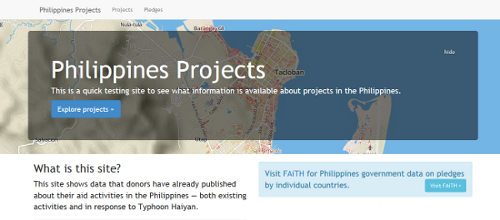A closer look at aid in the Philippines

In the aftermath of the devastating Typhoon Yolanda on 8th November, there have been calls to ensure that aid is effectively coordinated, learning lessons from the way humanitarian relief and reconstruction efforts were delivered following the Haiti earthquake and the 2004 Indian Ocean tsunami.
Donors are already publishing large amounts of information about their traditional development activities through the International Aid Transparency Initiative (IATI).
Those donors publishing to IATI haven’t focused much on humanitarian aid, but we had to ask: could IATI also be used for humanitarian activities?
What’s already available through other systems
There are a few systems through which some data on the Philippines response is published. UNOCHA’s FTS, or Financial Tracking Service, provides a central point for organisations to report data on their humanitarian aid. However, in most cases it is a voluntary and manual way of reporting the information, which means it is difficult to keep up to date. As a data standard, IATI could provide a more effective way for organisations to share their data with FTS, as well as allowing the data to be more granular and detailed.
The Philippines government also set up their own portal for tracking pledges made by foreign governments, called the Foreign Aid Transparency Hub, or FAiTH. IATI might also be able to help here by providing information on whether those pledges have actually been delivered on (and how), through granular disbursement and expenditure data.
What data is already available through IATI?
Bill Anderson from the IATI Secretariat recently pointed out that a quite a lot of information is already available about activities in the Philippines through IATI. The IATI Datastore pulls all these activities together, making it much easier to access and use the data. However, the data is returned as CSV, JSON, or XML – perfect for developers, but still a bit difficult to use by everyone else. So, we put together a quick projects browser to see what information is currently available in the Philippines. There’s a technical write-up on the OKFN Labs blog if you want more details on exactly how we did it.
What’s there, and what’s missing
Again – it’s important to note that donors have been focusing on publishing their traditional development activities to IATI. But many of the concepts involved are very similar. The fundamental model of one organisation giving funds to another for a specific activity, with various classifications of that activity and financial data, is still relevant in this context.
In total there are 27 activities in the Philippines in the IATI datastore that began since early November. All of these are from either GlobalGiving (which reports live data to IATI) or UNOCHA FTS (Financial Tracking Service). You can also look at a wider scope by looking at projects that started a bit earlier, to understand what development projects might be ongoing.
But the data is limited. Only two organisations are currently publishing data on their response to the typhoon. Other donors are certainly doing other activities, but it appears they are not publishing frequently enough for those projects to show up in the data yet.
The data also needs better delineation between humanitarian and development projects, and to identify projects which are relevant to particular crises – so that you could, for example, pull out all of the projects for Haiyan. FTS’ IATI feed already provides some of this data, but it isn’t visualised in our projects browser yet, because those fields aren’t used by other publishers so it could be misleading.
Where next for humanitarians and IATI?
This brief analysis of the data suggests:
- IATI needs some better classifications for humanitarian projects. A workshop in Geneva earlier this month discussed some of the additional information items that may be needed for humanitarian projects, such as a humanitarian marker and the name of the crisis that a project is part of. Work is ongoing between UNOCHA and the IATI Secretariat.
- More timely publication will be needed for humanitarian projects. Two weeks into the crisis, there is still limited information available. Donors can start by giving more information to UNOCHA FTS where possible. Building IATI into systems should help this data to be shared more quickly and reliably through automated feeds.
- We need a broader conversation between the IATI community and the humanitarian sector about how IATI data could be useful in a crisis to help coordinate aid more effectively. Specifically, under what circumstances IATI would be useful, which fields are most needed, and what other information is required.
The Philippines project browser is available here: http://pwyf.github.io/philippines
Give us your feedback below, or via @aidtransparency


[…] the Philippines is drawing attention for what it hasn’t provided: transparency in aid. Publishwhatyoufund.org takes a closer look at what’s been […]